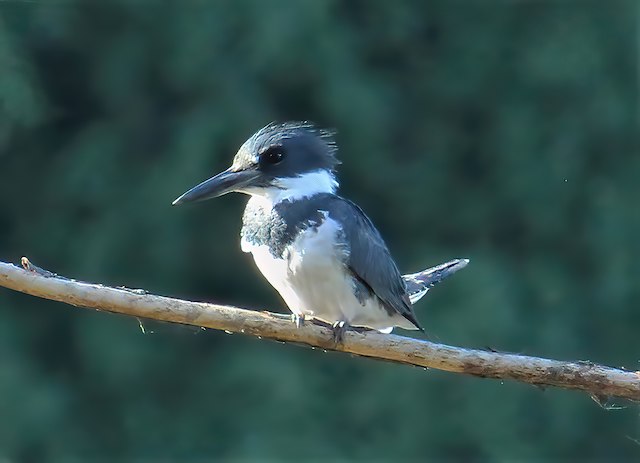A few months ago, I wrote about tyrant flycatchers, including the Eastern Kingbird and called them the “kings” of the Fox River Valley for their ferocious feeding habits and their generally fierce (for a cute little bird anyhow) behavior. This month, I’m writing about another bird with a “royal” title for many of the same reasons: the Belted Kingfisher.
I love to fish in the Fox River! Over the years, I’ve become pretty good at it. My skills, and those of my fellow fishermen and fisherwomen, pale in comparison to those of our avian friends. The herons, egrets, ospreys, cormorants and others, along with the Belted Kingfisher put our angling skills to shame! That’s ok though. Watching these great avian anglers plying their trade while out on the river is a real treat to see and can offer some tips to an observant and open-minded fisherfolk. All of these birds exercise patience, stealth, and close observation of their riverine surroundings to be successful in pursuit of their finny prey. Those traits: patience, stealth, and careful observation of our surroundings are all directly correlated with the success of us human anglers as well!
Meet the King

The Belted Kingfisher (Megaceryle alcyon) is the only member of the Kingfisher (Alcedinidae) family that occurs in our area. The Green Kingfisher and the Ringed Kingfisher occur occasionally in the far southwestern areas of the United States but never occur this far north. There are over 100 kingfisher species that are distributed in temperate and tropical regions throughout the world.
The Belted Kingfisher is fairly common along the Fox River. If you have canoed or kayaked the river or fished it from a boat or by wading, or even have hiked along a riverside trail, you have probably seen or heard a Belted Kingfisher. They are territorial birds that will scold interlopers, both avian and human, with their rattling chattering call, often escorting the interloper down river out of their territory. I have often witnessed this behavior from my boat as I drift with the current downstream. A Belted Kingfisher will become agitated by my presence and will fly with me down the river, chattering all the way until I reach the limits of his or her territory. He/she will then retire back to their perch while the next Kingfisher downstream takes up their noisy escort! Belted Kingfishers typically perch on a riverside branch to keep a lookout for fish and crayfish in the water below, which are their primary prey. They may also fly above the river and, when they spot a fish below, hover midair with rapidly beating wings before diving head-first into the water to seize their prey with their large, powerful and sharp bill.
The Belted Kingfisher is a medium sized bird (a little bit larger than a robin) that has primarily bluish-grey plumage on it’s back and wings. They also have a white chest with a blue-grey chest band that runs horizontally across their upper chest area. Females, who are slightly larger than the males, also have a rusty-colored belly band or “belt” that runs horizontally across their belly. This “belt” is the source of the Belted Kingfisher’s name. The Belted Kingfisher is one of the few birds in the world where the females are more colorful than the males.

Royal Tidbits
An interesting and unusual fact about the Belted Kingfishers is their nesting behavior. Belted Kingfishers dig burrows into soft soil along riverbanks or riparian embankments and nest underground in these burrows! These nesting tunnels generally slope upward from their entrance and are usually between one and eight feet long. Another interesting fact about Belted Kingfishers is that they regurgitate pellets similar to an owl that consist of the indigestible scales, bones, and shells of the fish and crayfish that they consume!

Parting Thoughts
I always consider it a real treat when I hear the rattling call of a Kingfisher when I’m down by the river and an even bigger treat when I see one of these fascinating and beautiful birds. It’s even more fun when I’m able to spend a little time watching them hunt from their perch or seeing them dive into the water from their hovering flight above the river to successfully catch their prey! Next time you’re out on or along the river, keep your eyes and ears open for these interesting birds!
Until next month, stay cool and enjoy the many natural wonders provided by our beautiful Fox River!


